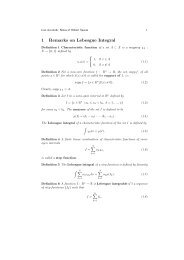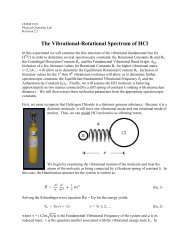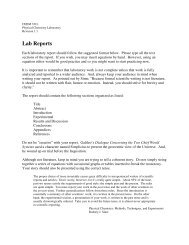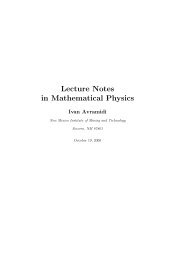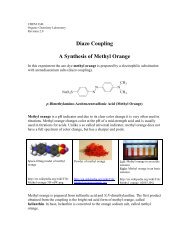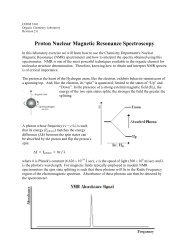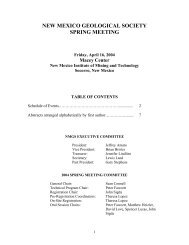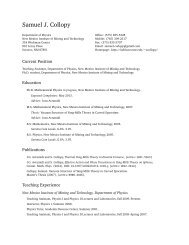A Magnetic α Ï Dynamo in Active Galactic Nuclei Disks - NMT Physics
A Magnetic α Ï Dynamo in Active Galactic Nuclei Disks - NMT Physics
A Magnetic α Ï Dynamo in Active Galactic Nuclei Disks - NMT Physics
You also want an ePaper? Increase the reach of your titles
YUMPU automatically turns print PDFs into web optimized ePapers that Google loves.
– 5 –1.4. The Turbulent <strong>Dynamo</strong>There are two pr<strong>in</strong>ciple problems with turbulent dynamos: first, the difficulty of deriv<strong>in</strong>g anet and sufficient helicity from random turbulent motions, and secondly, the ease with which theturbulent motions themselves can be suppressed by the back reaction of the field stress, <strong>in</strong> thiscase the multiplied toroidal field (Va<strong>in</strong>shte<strong>in</strong>, Parker, & Rosner 1993). Regardless of the source ofsuch turbulence, i.e., the α viscosity (Shakura & Sunyaev 1973), the magneto-rotational <strong>in</strong>stability(Balbus & Hawley 1998) or magnetic buoyancy (Chakrabarti, Rosner, & Va<strong>in</strong>shte<strong>in</strong> 1994), the turbulentstress will be small compared to the stress of Keplerian motion. The stress of the magneticfield produced will be limited by the back reaction on this turbulence. As discussed later the backreaction would limit the stress of the dynamo fields to values very much less than the Keplerianstress.The problem of the orig<strong>in</strong> of reconnection rema<strong>in</strong>s, but here turbulence <strong>in</strong> the disk can helpwhere one needs only assume that the flow of energy <strong>in</strong> turbulence is always dissipative and thatthe fraction of magnetic energy dissipated by this turbulence may be very small yet satisfy thenecessary reconnection. Secondly, fast reconnection (at near Alvén speed) <strong>in</strong> low beta, collisionlessplasmas has been modeled (Li et al. 2003; Drake et al. 2003).We note that we are not consider<strong>in</strong>g turbulence as a significant source of helicity <strong>in</strong> the αωdynamo, yet at the same time <strong>in</strong>vok<strong>in</strong>g turbulence <strong>in</strong> order to enhance reconnection.1.5. The Astrophysical ConsequencesWe are attempt<strong>in</strong>g to demonstrate that a robust dynamo <strong>in</strong> an accretion disk, dependentupon a small mass fraction of orbit<strong>in</strong>g stars, becomes a dom<strong>in</strong>ant magnetic <strong>in</strong>stability of CMBHformation. To the extent to which this <strong>in</strong>deed is so and s<strong>in</strong>ce orbit<strong>in</strong>g stars and Keplerian accretionare universal, then it becomes difficult to avoid the conclusion that the free energy of formation ofmost CMBHs would be converted <strong>in</strong>to magnetic energy.In our view the magnetic field, both energy and flux, generated by the black hole accretiondisk dynamo presumably powers the jets and the giant magnetized radio lobes. For us both of thesephenomena are most likely the on-go<strong>in</strong>g dissipation by reconnection and synchrotron emission offorce-free helices of wound up strong magnetic field produced by the accretion disk dynamo. (Thelarge scale magnetic flux, as <strong>in</strong>dicated by polarization observations where the correlation length is oforder the distance between bright knots, M87, Owen, Hardee & Bignell (1980) is equally demand<strong>in</strong>gof the coherence of the dynamo process.) The electromagnetic mechanism of extraction of angularmomentum and energy from the accretion disk has been proposed by Blandford (1976) and Lovelace(1976). Recently, the process of formation of such a force-free helix by shear<strong>in</strong>g of the foot-po<strong>in</strong>ts ofthe magnetic field by the rotation of the accretion disk has been considered by Lynden-Bell (1996)and Ustyugova et al. (2000); Li et al. (2001a); Lovelace et al. (2002). The magnetic dynamo <strong>in</strong> the




